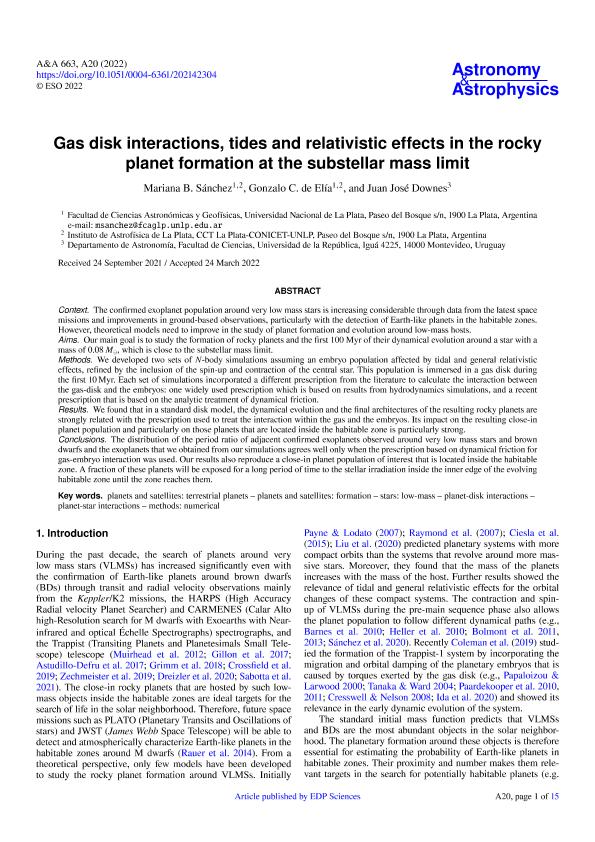Mostrar el registro sencillo del ítem
dc.contributor.author
Sánchez, Mariana Belén

dc.contributor.author
de Elia, Gonzalo Carlos

dc.contributor.author
Downes, Juan Jose
dc.date.available
2023-09-08T13:21:57Z
dc.date.issued
2022-07
dc.identifier.citation
Sánchez, Mariana Belén; de Elia, Gonzalo Carlos; Downes, Juan Jose; Gas disk interactions, tides and relativistic effects in the rocky planet formation at the sub-stellar mass limit; EDP Sciences; Astronomy and Astrophysics; 663; 7-2022; 1-15
dc.identifier.issn
0004-6361
dc.identifier.uri
http://hdl.handle.net/11336/210911
dc.description.abstract
Context. The confirmed exoplanet population around very low mass stars is increasing considerable through data from the latest space missions and improvements in ground-based observations, particularly with the detection of Earth-like planets in the habitable zones. However, theoretical models need to improve in the study of planet formation and evolution around low-mass hosts. Aims. Our main goal is to study the formation of rocky planets and the first 100 Myr of their dynamical evolution around a star with a mass of 0.08 M·, which is close to the substellar mass limit. Methods. We developed two sets of N-body simulations assuming an embryo population affected by tidal and general relativistic effects, refined by the inclusion of the spin-up and contraction of the central star. This population is immersed in a gas disk during the first 10 Myr. Each set of simulations incorporated a different prescription from the literature to calculate the interaction between the gas-disk and the embryos: one widely used prescription which is based on results from hydrodynamics simulations, and a recent prescription that is based on the analytic treatment of dynamical friction. Results. We found that in a standard disk model, the dynamical evolution and the final architectures of the resulting rocky planets are strongly related with the prescription used to treat the interaction within the gas and the embryos. Its impact on the resulting close-in planet population and particularly on those planets that are located inside the habitable zone is particularly strong. Conclusions. The distribution of the period ratio of adjacent confirmed exoplanets observed around very low mass stars and brown dwarfs and the exoplanets that we obtained from our simulations agrees well only when the prescription based on dynamical friction for gas-embryo interaction was used. Our results also reproduce a close-in planet population of interest that is located inside the habitable zone. A fraction of these planets will be exposed for a long period of time to the stellar irradiation inside the inner edge of the evolving habitable zone until the zone reaches them.
dc.format
application/pdf
dc.language.iso
eng
dc.publisher
EDP Sciences

dc.rights
info:eu-repo/semantics/openAccess
dc.rights.uri
https://creativecommons.org/licenses/by-nc-sa/2.5/ar/
dc.subject
METHODS: NUMERICAL
dc.subject
PLANET-DISK INTERACTIONS
dc.subject
PLANET-STAR INTERACTIONS
dc.subject
PLANETS AND SATELLITES: FORMATION
dc.subject
PLANETS AND SATELLITES: TERRESTRIAL PLANETS
dc.subject
STARS: LOW-MASS
dc.subject.classification
Astronomía

dc.subject.classification
Ciencias Físicas

dc.subject.classification
CIENCIAS NATURALES Y EXACTAS

dc.title
Gas disk interactions, tides and relativistic effects in the rocky planet formation at the sub-stellar mass limit
dc.type
info:eu-repo/semantics/article
dc.type
info:ar-repo/semantics/artículo
dc.type
info:eu-repo/semantics/publishedVersion
dc.date.updated
2023-09-05T18:03:50Z
dc.journal.volume
663
dc.journal.pagination
1-15
dc.journal.pais
Francia

dc.journal.ciudad
Paris
dc.description.fil
Fil: Sánchez, Mariana Belén. Consejo Nacional de Investigaciones Científicas y Técnicas. Centro Científico Tecnológico Conicet - La Plata. Instituto de Astrofísica La Plata. Universidad Nacional de La Plata. Facultad de Ciencias Astronómicas y Geofísicas. Instituto de Astrofísica La Plata; Argentina
dc.description.fil
Fil: de Elia, Gonzalo Carlos. Consejo Nacional de Investigaciones Científicas y Técnicas. Centro Científico Tecnológico Conicet - La Plata. Instituto de Astrofísica La Plata. Universidad Nacional de La Plata. Facultad de Ciencias Astronómicas y Geofísicas. Instituto de Astrofísica La Plata; Argentina
dc.description.fil
Fil: Downes, Juan Jose. Universidad de la República; Uruguay
dc.journal.title
Astronomy and Astrophysics

dc.relation.alternativeid
info:eu-repo/semantics/altIdentifier/url/https://www.aanda.org/articles/aa/full_html/2022/07/aa42304-21/aa42304-21.html
dc.relation.alternativeid
info:eu-repo/semantics/altIdentifier/doi/http://dx.doi.org/10.1051/0004-6361/202142304
Archivos asociados
